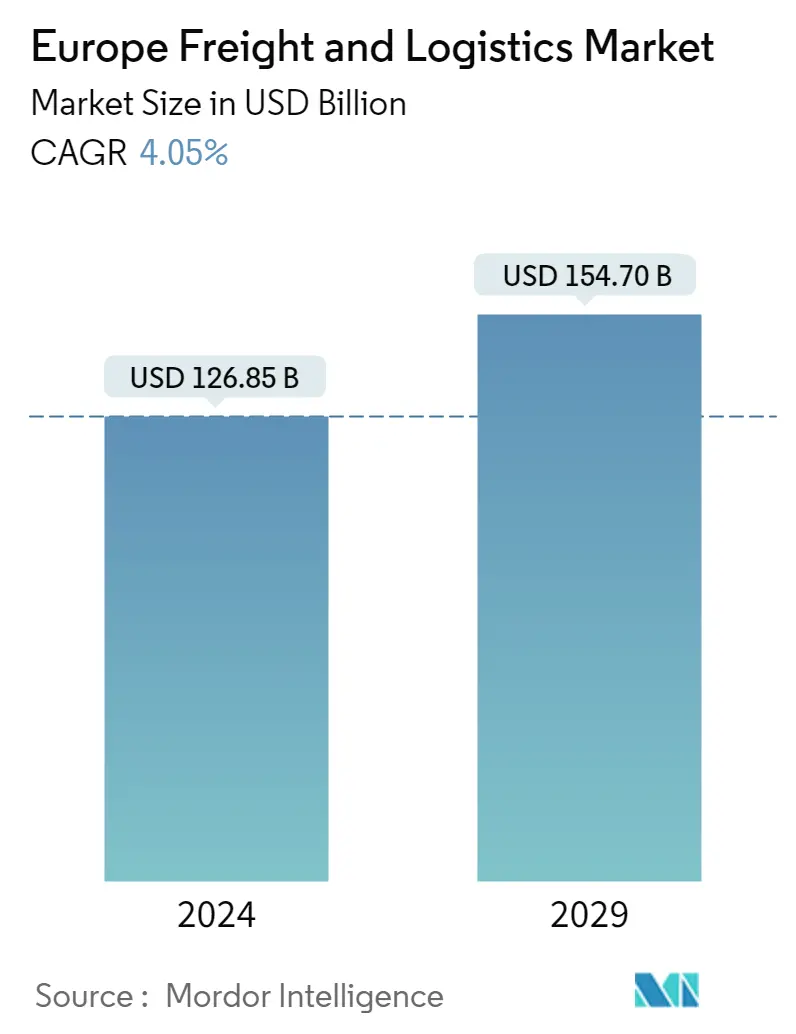Market Size of Europe Freight and Logistics Industry

| Study Period | 2020 - 2029 |
| Base Year For Estimation | 2023 |
| Market Size (2024) | USD 126.85 Billion |
| Market Size (2029) | USD 154.70 Billion |
| CAGR (2024 - 2029) | 4.05 % |
| Market Concentration | Low |
Major Players
*Disclaimer: Major Players sorted in no particular order |
Central and Eastern Europe Freight & Logistics Market Analysis
The Europe Freight and Logistics Market size is estimated at USD 126.85 billion in 2024, and is expected to reach USD 154.70 billion by 2029, growing at a CAGR of 4.05% during the forecast period (2024-2029).
- Eastern European countries, like Poland, the Czech Republic, Romania, Hungary, Bulgaria, and Slovakia, are among the fast-growing economies in Europe. Such strong economic performance is prompting countries in Eastern Europe to demand a greater say in the future of the European Union. With Germany dominating the logistics market, the eastern countries have to work a lot to increase their market share. In particular, Eastern European countries need to address issues such as poor infrastructure, political corruption, lack of competitiveness, staff shortages, etc.
- The logistics market in the region has been impacted due to COVID-19 restrictions with the decrease in volumes of freight transported. However, the demand has picked up, and with the growth in e-commerce, the market has recovered.
- The rapid growth in the e-commerce segment will support the growth of the logistics market in the region. While Germany and the United Kingdom remain the top e-tailing markets in Europe, the fastest growth is expected to take place in Eastern Europe, with Poland leading the growth.
- Rapidly growing online sales, a large consumer market, access to a relatively cheap labor force, and an established logistics market make Poland an exceptionally attractive location for international e-tailers.
- Existing online retailers are likely to continually expand their warehouse space in the coming years, while new market players may search for suitable facilities and supply chain operators. Increasing demand for appropriate distribution space, as well as tailored logistics services, puts pressure on developers and 3PLs to adjust their offer to meet these new requirements.
- Despite the unstable environment, logistics operators have been clamping down cooperation year by year, offering a growing range of services with a modern technology and significant capacity.
- The logistics sector in Eastern Europe is a relatively young market. In Poland, there are more than 13.4 million sq. m of modern warehouses and the demand for warehouse space is growing gradually. Also driving this growth are the relatively cheap costs in CEE, which have attracted companies, such as Amazon (Slovakia) and Alibaba (Poland).
Central and Eastern Europe Freight & Logistics Industry Segmentation
Freight refers to any type of goods, items, or commodities that are transported in bulk via air transport, surface transport, or sea/ocean transport. Logistics refers to the overall process of managing how resources are acquired, stored, and transported to their final destination.
A complete background analysis of the CEE freight and logistics market includes an assessment of the economy and the contribution of sectors in the economy, a market overview, market size estimation for key segments, and emerging trends in the market segments, market dynamics, logistics spending by the end-user industries, and geographical coverage.
The freight and logistics market in Central and Eastern Europe is segmented by Function (freight transport, freight forwarding, warehousing, and value-added services), By End User (manufacturing and automotive, oil and gas, mining, and quarrying, agriculture, fishing, and forestry, construction, distributive trade, healthcare and pharmaceutical, and other end users) and By Country. The report offers market size and forecasts in value (USD billion) for all the above segments.
| Function | ||||||
| ||||||
| Freight Forwarding | ||||||
| Warehousing | ||||||
| Value-added Services and Other Functions |
| End User | |
| Construction | |
| Oil and Gas and Quarrying | |
| Agriculture, Fishing, and Forestry | |
| Manufacturing and Automotive | |
| Distributive Trade | |
| Other End Users (Pharmaceutical and Healthcare) |
| Country | |
| Germany | |
| United Kingdom | |
| France | |
| Italy | |
| Spain | |
| Russia | |
| Netherlands | |
| Poland | |
| Rest of Europe |
Europe Freight and Logistics Market Size Summary
The Central and Eastern Europe freight and logistics market is experiencing significant growth, driven by the rapid expansion of e-commerce and the region's strategic geographical position. Countries like Poland, the Czech Republic, and Romania are emerging as key players, benefiting from their proximity to Western Europe and relatively low labor costs. The logistics sector in these countries is evolving, with increasing demand for modern warehouses and tailored logistics services. Despite challenges such as infrastructure issues and political corruption, the market is recovering from the impacts of COVID-19, with a notable rise in freight volumes. The region's logistics landscape is characterized by a mix of global and regional players, with Western European companies establishing operations in Central and Eastern Europe to leverage cost advantages while serving high-cost markets like Germany and France.
Poland stands out as the largest logistics market in the region, with a robust transportation infrastructure and a growing demand for logistics services. The country is attracting international e-tailers due to its large consumer market and expanding warehouse space. The logistics market is fragmented, with both global giants and regional developers investing in new facilities to meet the increasing demand. Cross-border trade is also on the rise, prompting modernization of border infrastructure in collaboration with neighboring countries. The region's logistics sector is poised for continued growth, supported by the booming e-commerce industry and strategic investments in infrastructure and technology.
Europe Freight and Logistics Market Size - Table of Contents
-
1. MARKET INSIGHTS AND DYNAMICS
-
1.1 Current Market Scenario
-
1.2 Value Chain/Supply Chain Analysis
-
1.3 Government Regulations and Initiatives
-
1.4 Technology Innovation and its Impact
-
1.5 Insights into the E-commerce Industry in the Region (both Domestic and Cross-border)
-
1.6 Spotlight - Freight Transportation Costs/Freight Rates
-
1.7 Insights into the Trans-European Transport Network
-
1.8 Insights into the Courier, Express, and Parcel Market
-
1.9 Spotlight on the China-Europe Rail Freight Transport Sector
-
1.10 Impact of COVID-19 on the Market
-
1.11 Market Dynamics
-
1.11.1 Market Drivers
-
1.11.2 Market Restraints
-
1.11.3 Market Opportunities
-
-
1.12 Industry Attractiveness- Porter's Five Forces Analysis
-
1.12.1 Bargaining Power of Buyers/Consumers
-
1.12.2 Bargaining Power of Suppliers
-
1.12.3 Threat of Substitute Products
-
1.12.4 Intensity of Competitive Rivalry
-
1.12.5 Threat of New Entrants
-
-
-
2. MARKET SEGMENTATION
-
2.1 Function
-
2.1.1 Freight Transport
-
2.1.1.1 Road
-
2.1.1.2 Rail
-
2.1.1.3 Sea and Inland
-
2.1.1.4 Air
-
-
2.1.2 Freight Forwarding
-
2.1.3 Warehousing
-
2.1.4 Value-added Services and Other Functions
-
-
2.2 End User
-
2.2.1 Construction
-
2.2.2 Oil and Gas and Quarrying
-
2.2.3 Agriculture, Fishing, and Forestry
-
2.2.4 Manufacturing and Automotive
-
2.2.5 Distributive Trade
-
2.2.6 Other End Users (Pharmaceutical and Healthcare)
-
-
2.3 Country
-
2.3.1 Germany
-
2.3.2 United Kingdom
-
2.3.3 France
-
2.3.4 Italy
-
2.3.5 Spain
-
2.3.6 Russia
-
2.3.7 Netherlands
-
2.3.8 Poland
-
2.3.9 Rest of Europe
-
-
Europe Freight and Logistics Market Size FAQs
How big is the Europe Freight and Logistics Market?
The Europe Freight and Logistics Market size is expected to reach USD 126.85 billion in 2024 and grow at a CAGR of 4.05% to reach USD 154.70 billion by 2029.
What is the current Europe Freight and Logistics Market size?
In 2024, the Europe Freight and Logistics Market size is expected to reach USD 126.85 billion.

